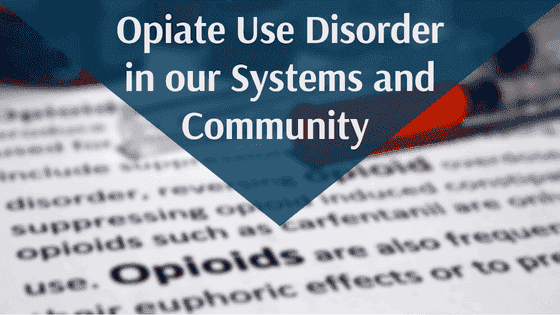
Opiate Use Disorder in our Systems and Community
I have been a substance use counselor for nearly 17 years. When I started, a patient who used opioids or heroin was uncommon; now, if a patient has not used opioids or has never overdosed, we are mildly surprised. When suboxone (buprenorphine) arrived on the scene, we all thought our opioid crisis was over; little did we know. I was talking to one of my coworkers, who is friends with one of the local EMTs; she stated that our town has 6-10 overdoses daily. The population of our town is only around 100,000 people.
From the creation of morphine in the early 1800s, opioids have been a tool to manage pain as well as tempt us with addiction. The business of opioids in the 1980s saw the predatory nature of greed and facilitated the "opioid crisis" that we are experiencing now (Quinones, 2015). Currently, an estimated 2.7 million Americans live with opioid use disorder (OUD); around 25% of people prescribed an opioid develop an addiction (Montvale, 2022). As a country, we experience around 130 deaths per day from opioid use disorder. In addition, the ripple effect of opioid addiction in our country negatively impacts our criminal justice, education, child welfare, and social services systems to around one trillion dollars annually (Chaney, Mathia, and Cole, 2022).
Our criminalization and stigma of the addicted individual were exacerbated with the Harrison Act of 1914 and the creation of the Narcotic Farm, where opiate (specifically heroin) addicted individuals were often sent or voluntarily went. Here, service work and physical activity were used as treatment modalities. Addicts were also used for research on how to manage opioid addiction and perhaps treat it (Quinones, 2015). Additionally, numerous studies have pointed to the influence of substances on our incarcerated populations (some estimates indicate 80% of incarcerated individuals are there due to a drug/alcohol-related crime), leading many to see our prisons and jails as venues for treatment (Mate, 2010). This dynamic has only served to exacerbate the stigma of addiction and impair our ability to treat this as a disease versus a moral failing or lack of willpower.
From the perspective of a treatment provider, opioids have also caused us to consider what indeed is "recovery" in that the abstinence-based model is no longer as defined. If someone is using a medication prescribed by their provider, are they actually in recovery? Are they actually sober? Or are they just dependent on a legal, insurance-covered drug? Our reliance on the traditional 28-day inpatient/residential treatment program is also shifting to an outpatient-based model utilizing medication such as buprenorphine to help manage withdrawal and craving. For addiction professionals also in recovery, the debate can become even more heated as the traditional abstinence-based model is questioned. The American Society of Addiction Medicine (ASAM) has helped us better define evidence-based practices for helping individuals who struggle with OUD and diffuse stigma. Shifting to a medical-based perspective may indeed help us further lessen the prejudice that surrounds addiction in general, not just those with OUD. ASAM's definition of addiction speaks to it being a "treatable, chronic medical disease involving complex interactions among brain circuits, genetics, the environment, and an individual's life experiences" (ASAM, 2020). While this deviates mildly from a true medical model, it also helps us recognize the true complexity of addiction and, thus, the recovery process.
Resources:
ASAM. (2020). National Practice Guideline for the Treatment of Opioid Use Disorder. Washington, DC.
Chaney, L., Mathia, C., Cole, T. (2022). Transitioning patient with opioid use disorder from methadone to buprenorphine. Current Psychiatry, 21(12). December 2022. Doi: 10.12788/cp.0305
Mate, G (2010). In the Realm of Hungry Ghosts. North Atlantic Books. Berkely, California.
McKowen, J (2022). Health Monitor Living: Opioid Use Disorder. Montvale, NJ.
Quinones, S. (2015). Dreamland. Bloomsbury Press. New York, NY.
**********
We welcome guest columnist Malcolm Horn. Dr. Horn is a TCI's Advisory Board member and has provided courses for TCI on topics such as Opiate Use Disorder, SUD, and Clinical Supervision Licensure and Telehealth.
About Dr. Malcolm Horn, PhD, LCSW, LAC, SAP, MAC:
Malcolm Horn-Charnesky started her career working with the elderly and adults with disabilities. She has over 10 years of progressive clinical experience working with the complex diagnoses that often accompany addictions and co-occurring disorders. Malcolm started working specifically with addictions in 2006 when she moved to Billings and started working at Rimrock. She coordinates the continuing education for licensed staff, ensuring they have opportunities to appropriate continuing education units to improve their skills and ability to meet the needs of clients. Malcolm also supervises and coordinates the internship program and ensures all learning objectives are met. She provides educational lectures and workshops to patients and community members and also conducts adjunctive group, family, and individual therapy.
Malcolm received her Master’s in Social Work from Walla Walla College, is a Licensed Clinical Social Worker, and is licensed by the state of Montana as an Addiction Counselor. She also has accreditation from the NAADAC (National Association of Alcohol and Drug Addiction Counselors) as a Masters level Addiction Counselor. She is a SAP (Substance Abuse Professional) certified by the DOT through NAADAC as well as the only nationally certified intervention professional (NCIP) in Montana. Malcolm was the President of the Montana Association of Drug and Alcohol Counselors from 2015-2017 and is the current regional vice president for the national association. She is the president-elect of NAADAC and teaches two courses at Montana-State University-Billings. Malcom completed her Ph.D. in psychology in April of 2019.
Testimonials
Bridgette Nalumu
Public health consultant, Green and Purple Consultancy Network
Lora Verley
Clinical Therapist, Bayless Integrated Healthcare
Jackie Tanna
Therapist, Region One Mental Health
Jackie Bell-Russell
Therapeutic Behavioral Strategist, Rialto Unified School District